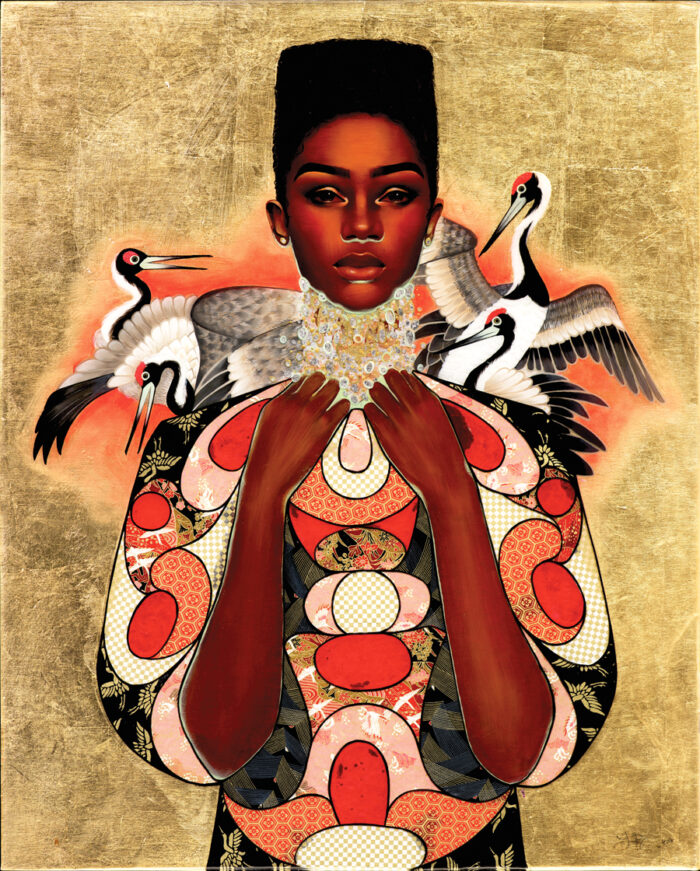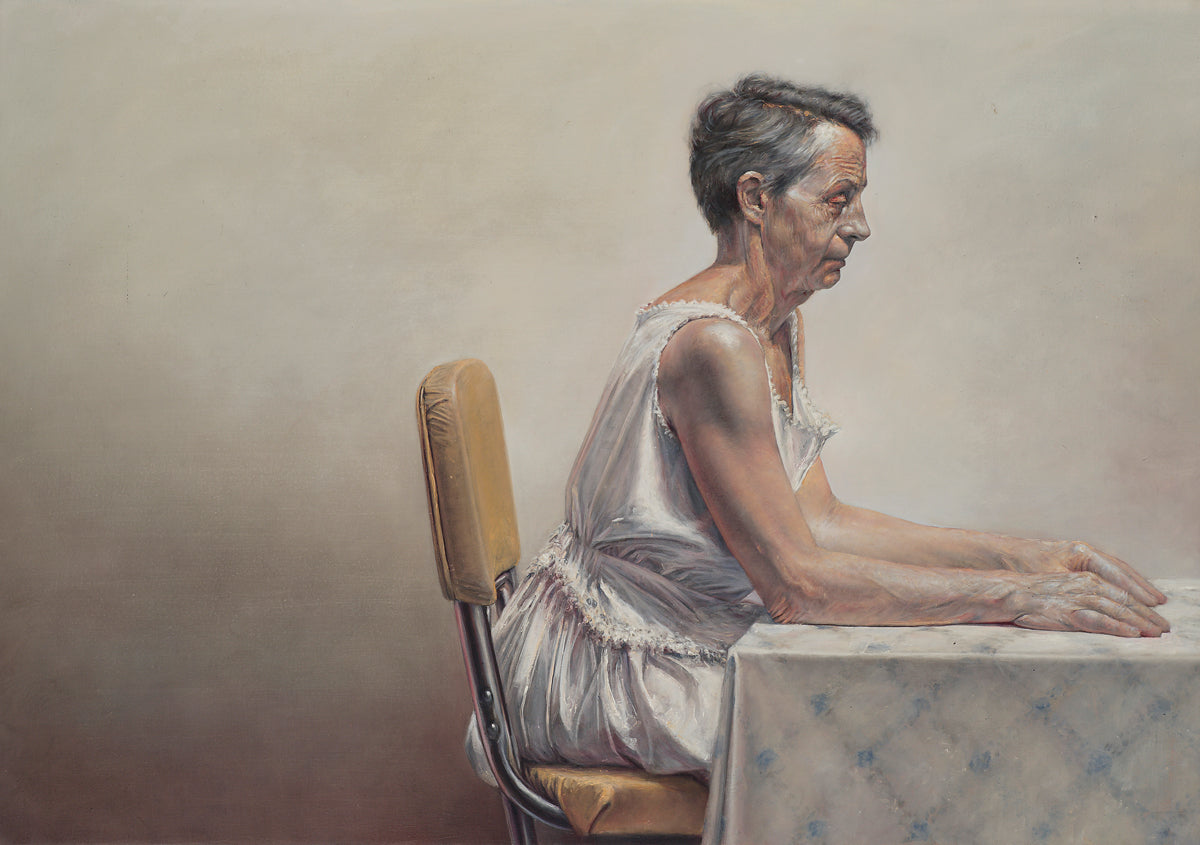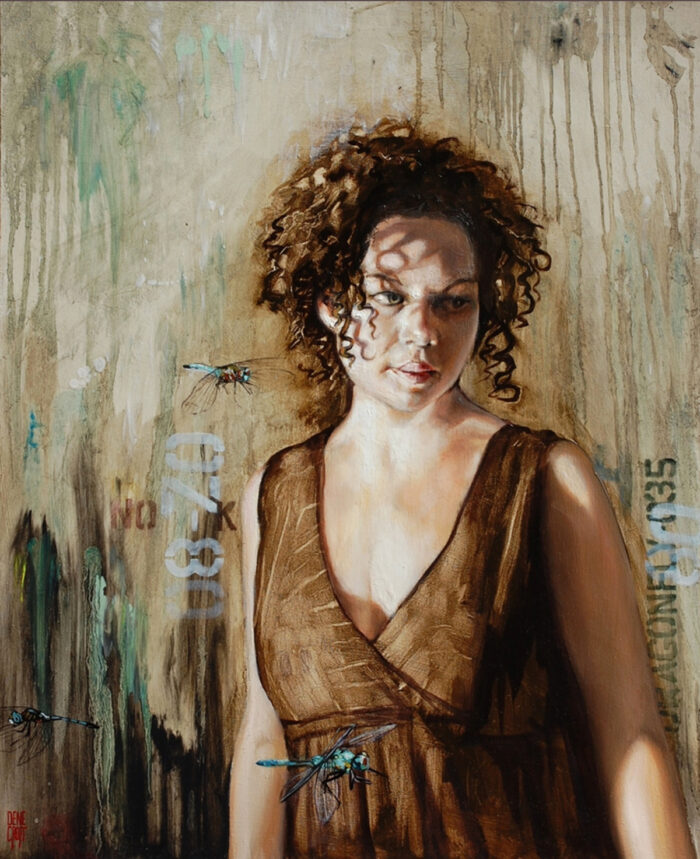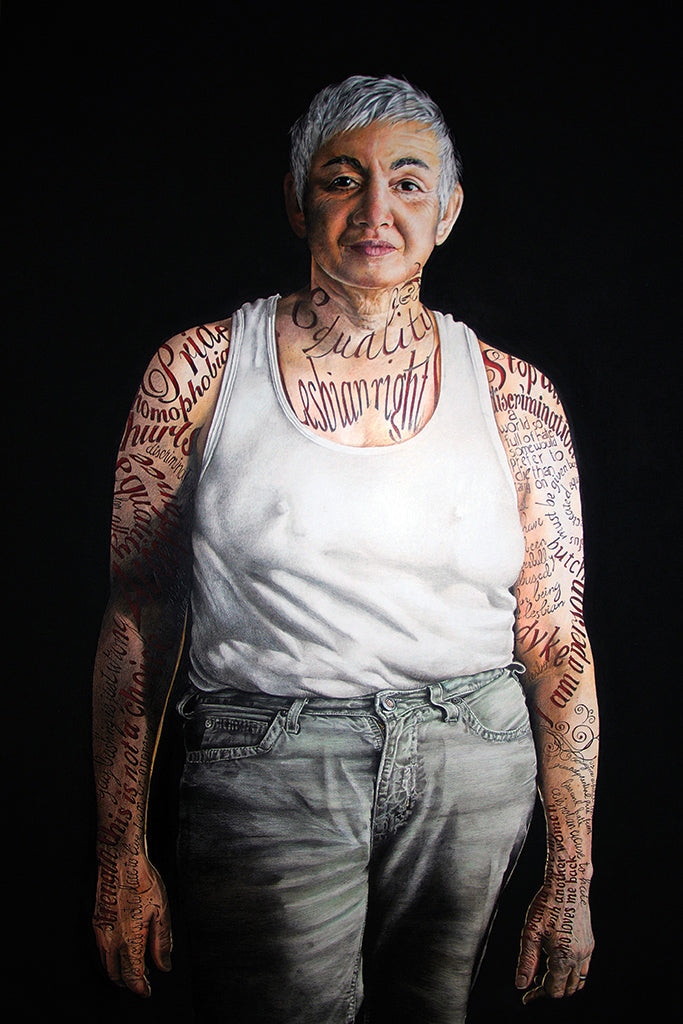Face it, Portraits Speak Volumes
September 18, 2019LAUREN BREVNER

Divine Skin – Oils, Acrylic, metal leaf, resin, and mixed media on wood panel
“I find that people are endlessly
fascinating and there is so much to
explore within portraiture.”
Why is it important to you and your art practice to paint/draw people?
Portraiture is something I connected with before I was an artist, which made it a natural transition when I decided to teach myself how to paint. I find that people are endlessly fascinating and there is so much to explore within portraiture.
What are you hoping to capture or express through this subject matter?
I can only express what I know, which is my perspective. I do try to capture certain emotions in my work, mainly when I’m painting women. I hope to portray women as strong, confident and powerful and at the same time express the importance of my own mixed heritage.
What advice would you give to someone who is just starting to paint or draw people?
As much as life drawing is awesome, sometimes it’s not always comfortable for beginners – drawing from photos that you love in the beginning is a good starting point. The most important thing regardless is to draw as much as possible!
Which 3–5 favourite products are you currently using in your portraits?
I’ve gradually started to incorporate the use of acrylics more into my work; I love golden fluid acrylics for that. I’m also using Gamblin oils, Opus wood panels and art resin.
JAY SENETCHKO

I Remember That Yellow Chair – Oils on canvas
“I believe in the social importance of art.”
Why is it important to you and your art practice to paint/draw people?
I believe in the social importance of art, but in order for it to be socially effective, people must be interested enough to engage with it. One of the most direct ways of doing this is through the power of story and in visual art one of the most familiar vehicles of storytelling is the human form. People respond to the expression of body and face in their relation to surrounding environments in a way that makes figurative art an excellent vehicle for storytelling. As such, I believe that stories have the power to transform people, and that as a result figurative art is a uniquely effective way of affecting society.
What are you hoping to capture or express through this subject matter?
I think that what I am trying to capture is a complex blend of topical events, personal and familiar histories, theoretical and historical references, as well as an overall mood and feeling. That being said, what I am most interested in on a superficial level is to create compelling pictures that entice the viewer to want to look at them. None of the other things I try very hard to put into my pictures, and that I believe are crucial to their success, get off the ground unless people want to spend time with them.
What advice would you give to someone who is just starting to paint or draw people?
Be patient. There’s lots to learn, it isn’t easy, and there’s no silver bullet. Take your time, and recognize there’s no finish line…so there’s no need to hurry.
Which 3–5 favourite products are you currently using in your portraits?
I use 12 or 14 duck cotton canvas (I like the extra weight), Gamblin, Holbein, and Old Holland oil paints, 50/50 linseed oil and turpentine medium, sandpaper, and different sizes of Legato flat brushes and a random selection of fan brushes.
DENE CROFT

Dragonfly – Oils
“I am known as a portrait painter, but I think
of myself as a painter of narratives with a
strong human element.”
Why is it important to you and your art practice to paint/draw people?
My interest in painting people was not so much about painting a portrait. I included people in my paintings as part of the narrative – the story I was attempting to tell in some of my earlier work. Originally my paintings were art deco inspired (film noir style images were what I had in mind) heavily inspired by Edward Hopper, Tamara de Lempicka and Gustav Klimt. My later paintings became more influenced by 16th/17th century master technique. I found a renewed appreciation for working with live models, expressing more of the human element in the work, and using a combination of grisaille, alla prima and glazing over oil grounds. I very often include silver and gold leaf to give the traditional approach a more contemporary look.
What are you hoping to capture or express through this subject matter?
I work mainly with women, and my models are as much actor as they are model. The human element that the model brings to the painting becomes an integral part of the effort to create an ethereal quality in the work. My paintings are narratives rather than portraits in the traditional sense. I want the viewer to interact with the painting, in that they are invited to make up the end of the story, or at least wonder about the story in the first place. I am known as a portrait painter, but I think of myself as a painter of narratives with a strong human element.
What advice would you give to someone who is just starting to paint or draw people?
At all cost avoid the temptation of using projectors and technological assists. Draw from life as much as possible, and if you’re painting from a photograph, take the time to set up the shot yourself. Use strong directional light: two light sources, one for primary and one for secondary light. Avoid borrowing published images that have been Photoshopped or altered for purposes of publication. The images usually look flat and lack the subtle contrasts of colour, shape and shadow that we are looking for in painting a portrait. Study the principle techniques of the masters. We are standing on the shoulders of history’s great painters and they really knew what they were doing. It behooves us all to take advantage of their wisdom and experience. There is a plethora of information out there on the various approaches that they took when painting portraits. Read as much as you can and study their finished paintings as much as possible. Make a couple of “master copies”. It is a perfectly acceptable (and time-honoured) step toward learning to paint your own portraits and enables you to better understand what it took for them to build the painting. Use the techniques that they employed and the experience will put you far further ahead than watching a YouTube video.
Which 3–5 favourite products are you currently using in your portraits? What is it about these products that you like?
As much as I am aware that I may not look it, I am pretty old school when it comes to products and my approach to painting generally. I keep things really simple. I use the traditional colours in my palette: titanium white, light red, cadmium orange, raw sienna, burnt umber, chrome oxide green and a little lamp black. I’m an oil painter, but I use acrylic brushes. I use linseed oil or walnut oil with a little solvent, but if I use a commercial medium I would favour Liquin. I always stretch my own canvas and I use 10 oz cotton rather than linen (I’ve never quite understood the advantages of using linen). I prepare my canvas with oil grounds rather than acrylic gesso. Oil grounds better reflect the light back through the paint. I very often incorporate silver leaf into my work, gilding the prepared surface and painting straight on top of the metal leaf. I use white shellac to seal the silver leaf as it accepts the paint better than acrylic sealers.
JEANETTE SIROIS

Equality of Same; Lorraine – Colour pencil on paper
“My goal is to capture the essence of the
moment between thought and realization.”
Why is it important for me and my practice to draw people?
I’m fascinated by the human face and form but drawing faces has always been a challenging subject for me as it requires a great deal of artistic skill to get the form, contouring and emotional message right. That’s what fascinates me as an artist. I want that challenge on multiple levels. It forces me to always be working at improving my skills. I challenge myself to keep working on form, details, and effectively illustrate the emotion being conveyed by my subject. I’m always looking at ways to combine visual elements together. I also work hard at pushing my materials, seeing what else they can do and exploring new methods of using them. For my art practice, portraiture is used to discuss social issues that are relevant now and are important to me. Portrait art is my way of connecting to these issues, to others and to the world.
What are you hoping to capture or express through this subject matter?
All my portrait work focuses on a given theme – for example, what it means to be LGBTQ or what living with mental illness means for women. I always sit with my subject and pose a question around the theme I’m working on, then I wait, study and look for their response. As we continue to explore the question their body language forms their response. That is what fascinates me about portraiture, facial expression is amazing. My goal is to capture the essence of the moment between thought and realization, when the subject expresses through their face and body that exact moment of revelation. It’s often a painful and difficult connection, and getting that moment on paper can be challenging but also incredibly rewarding when it works.
What advice would you give to someone who is just starting to paint or draw people?
What advice would I give? Practice and work as hard as you can. Spend hours and hours on art making. Being an artist is really hard work. Spend as much time as possible working on facial sketches, observing people, bone structure, facial positioning and light with form. I don’t believe being great at realism is a necessity. Being great at being you is more important. Get to be the best you can at form, structure, composition and colour, and understand how to use value masterfully. It doesn’t matter if you lean towards realism or abstract. Master the type of art making that fits for you and then you can effectively keep breaking the rules.
Which 3–5 favourite products are you currently using in your portraits?
Like all professional artists, I need the very best materials for my art practice. The pencils I use are considered to be some of the highest quality pencils on the market: Caran D’Ache Luminance and Pablo; Faber Castell Polychromos; and Prismacolor Premier on a beautiful substrate of 100% Cotton Stonehenge paper from Legion Papers, which I purchase by the 50” wide roll. The pencils must be of the highest rating for lightfastness, with an excellent pigment-to-binder ratio for purer, richer colour laydown which allows for multiple colour layers (sometimes up to twenty). These layers create texture, colour blending and visual interest. I combine them with solvents, blenders and fixatives, which enhance and preserve the finished works. I mount my work on custom-made cradled boards using the highest quality archival methods and standards.

